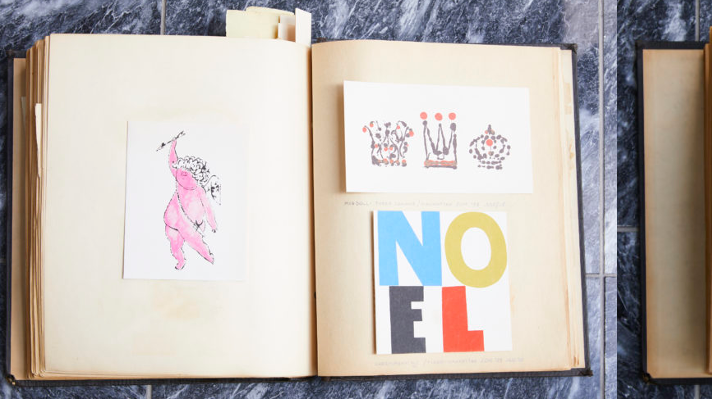In a time when correspondence and greeting cards for all occasions can be delivered to your inboxâor sent as an animated text messageâin seconds, thereâs still something incredibly satisfying about mailing (and opening!) an actual physical card through the post.
This is particularly true during the holiday season, when well-wishing cards fatten the mailbags of carriers across the country. Beginning in the 1940s, New Yorkâs Museum of Modern Art (MoMA) established a tradition for producing its annual holiday cardsâeven elevating them to an art form, so to speak. Since the inception of the museumâs holiday card program, the MoMA Design Store has worked closely with world-renowned artists like Pablo Picasso, Henri Matisse, Alexander Calder, Andy Warhol and, more recently, Takashi Murakami and Cindy Sherman to develop whimsical and unique greeting cards. Some have even emerged from their mailing envelopes to become iconic images in the lexicon of modern art.
âIn committee-meeting notes dated November 20, 1940, it was reported that the Museum of Modern Art was planning to produce holiday cards featuring artworks including Henri Rousseauâs The Sleeping Gypsy; Harlequin and Mother and Child by Picasso; and Agrarian Leader Zapata by Diego Rivera,â shares Chay Costello, the museumâs associate director of merchandising and product development. Over 80 years later, MoMA Design Storeâs holiday cards are still introduced each yearâthe designs for which are sourced through an open call. âArtists, illustrators, and paper engineers from across the globe send in submissions, and the Holiday Card Selection Committee reviews them all, works with card artists on alterations and revisions, and selects the final card line.â
Some of the earliest and most popular cards were designed by art-world luminaries whose original works from the same periods have gone on to achieve as high as nine figures at auction: In 1947, Alexander Calder created a playful illustration of a series of ice-skating animals, and in 1952, MoMA introduced its card designed by Andy Warhol featuring a putt-like illustration and a âHappy Holidaysâ greeting. And in 1965, Robert Indiana submitted a variety of 12-inch-square oil-on-canvas variations of his iconic LOVE image that, coincidentally, was created the year before as personal cards sent by the artist to several friends. â[The] LOVE holiday card is a MoMA favorite,â Costello says. âWhen we consider how iconic and well-known the artwork has become, it is wonderful to remember how it began in 1965 as a MoMA Holiday Card.â
Internationally recognized as a research center for modern and contemporary art, MoMAâs archives also house historical documents and records, including correspondence related to its holiday cards, samples of cards, and retail catalogs dating back to the start of World War II showing holiday cards on offer. âIn 1940, [the cards] were five cents apiece or six for 75 cents,â Costello notes. âIn addition to MoMAâs formal archive, MoMA Design Store maintains a working archive of cards and retail catalogs dating back many decades, which we use for research, reference, and inspiration.â
Some cards reappear as part of the MoMA holiday card line many years after their initial introduction. âIn 2005, I had the opportunity to work with Takashi Murakami on a holiday card design called Christmas Flowers,â Costello recalls. âWe recently reintroduced it, so it is back by popular demand.â Another of her personal favorites is William Kolanoâs 1992 card design, Looks Like Snow: âIt really showcases MoMA Design Storeâs early innovation with die-cutting and unique card formats, and when I saw this design, I knew we had to bring it back this year in a new color.â
This year, MoMA Design Storeâs holiday card line takes innovations in paper engineering to the next level. âSeveral cards, like our Merry Amaryllis, the Holiday Express train, and a card that pops up into a snowman ornament to hang on the tree, are constructed to become 3D objects when fully opened,â she adds, noting that the program has become an incubator for paper engineers who create cards that do much more than open at a fold. Aside from more traditional subject matter like doves, snowmen, Santa Claus, and reindeer, MoMA has also introduced some new motifs, such as Santa in a rocket ship and a card featuring festive seals. âOur customers have responded enthusiastically to these new themes, so we hope to introduce more unexpected ideas in the future.â


